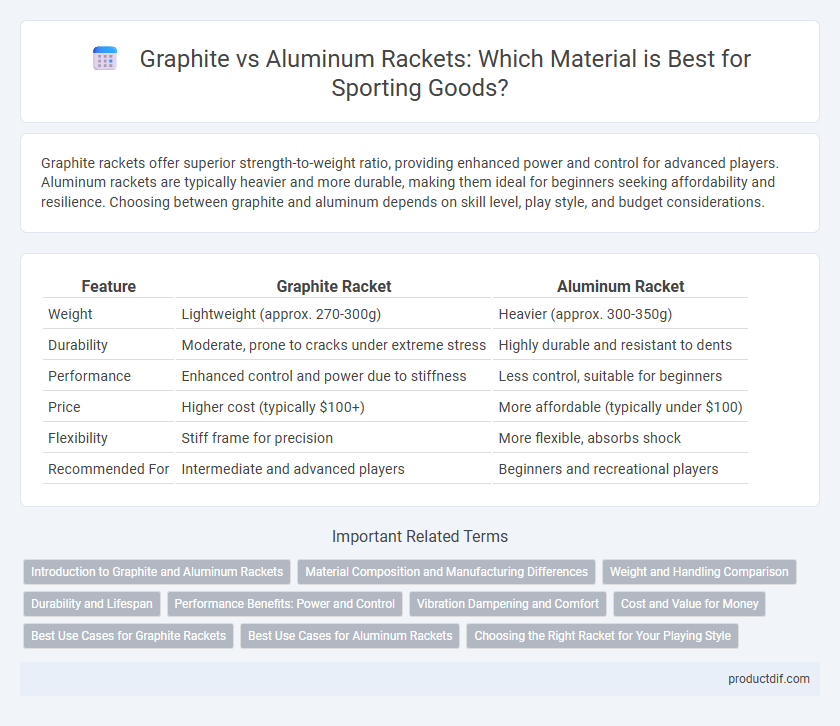Graphite rackets offer superior strength-to-weight ratio, providing enhanced power and control for advanced players. Aluminum rackets are typically heavier and more durable, making them ideal for beginners seeking affordability and resilience. Choosing between graphite and aluminum depends on skill level, play style, and budget considerations.
Table of Comparison
| Feature | Graphite Racket | Aluminum Racket |
|---|---|---|
| Weight | Lightweight (approx. 270-300g) | Heavier (approx. 300-350g) |
| Durability | Moderate, prone to cracks under extreme stress | Highly durable and resistant to dents |
| Performance | Enhanced control and power due to stiffness | Less control, suitable for beginners |
| Price | Higher cost (typically $100+) | More affordable (typically under $100) |
| Flexibility | Stiff frame for precision | More flexible, absorbs shock |
| Recommended For | Intermediate and advanced players | Beginners and recreational players |
Introduction to Graphite and Aluminum Rackets
Graphite rackets offer superior stiffness and lightweight properties, enhancing power and control for players seeking high performance. Aluminum rackets are typically heavier and more durable, making them ideal for beginners or recreational use due to their affordability and forgiveness on off-center hits. Understanding the material composition is crucial for selecting the right racket tailored to skill level and playing style.
Material Composition and Manufacturing Differences
Graphite rackets are composed primarily of carbon fibers woven into a composite matrix, offering superior stiffness and lightweight properties that enhance power and control. Aluminum rackets are made from a single metal alloy, resulting in increased durability but greater weight, which can reduce maneuverability and shock absorption. Manufacturing processes for graphite involve layering and curing carbon fiber sheets under heat and pressure, whereas aluminum rackets are typically formed through metal extrusion or casting, emphasizing mass production and cost efficiency.
Weight and Handling Comparison
Graphite rackets typically weigh between 270 to 320 grams, offering lightweight performance that enhances maneuverability and reduces player fatigue. Aluminum rackets, generally heavier at 310 to 350 grams, provide greater durability but can limit swift handling during fast-paced play. The reduced weight of graphite rackets enables quicker reaction times and improved swing speed, making them preferable for competitive athletes seeking agility on the court.
Durability and Lifespan
Graphite rackets offer superior durability due to their high tensile strength and resistance to wear, providing a longer lifespan compared to aluminum rackets. Aluminum rackets, while more affordable, are prone to bending and denting from repeated impacts, which can significantly reduce their usability over time. Investing in a graphite racket ensures consistent performance and longevity, ideal for frequent players seeking durable sporting equipment.
Performance Benefits: Power and Control
Graphite rackets offer superior power and control due to their lightweight composition and stiffness, allowing for faster swing speeds and precise shot placement. Aluminum rackets provide durability and affordability but often sacrifice responsiveness and finesse, making them less ideal for advanced players seeking optimal performance. Choosing graphite enhances maneuverability and energy transfer, resulting in improved overall gameplay.
Vibration Dampening and Comfort
Graphite rackets offer superior vibration dampening compared to aluminum rackets, enhancing comfort during extended play by reducing the shock transmitted to the player's hand and arm. The advanced composite materials in graphite absorb and dissipate impact vibrations more effectively, minimizing fatigue and the risk of injury. Aluminum rackets, while durable and cost-effective, tend to transmit more vibrations, resulting in less comfort and increased strain on joints during intense matches.
Cost and Value for Money
Graphite rackets typically cost more than aluminum rackets due to advanced materials and manufacturing processes, offering superior durability, enhanced control, and lighter weight. Aluminum rackets provide excellent value for money, making them a popular choice for beginners and casual players seeking affordable options without sacrificing basic performance. Investing in a graphite racket often yields better long-term benefits for serious athletes aiming to improve their game with precision and comfort.
Best Use Cases for Graphite Rackets
Graphite rackets offer superior stiffness and lightweight design, making them ideal for advanced players seeking precision and power in their swings. Their vibration-dampening properties reduce arm strain, which benefits players engaging in long, intense matches or training sessions. Graphite rackets excel in fast-paced sports like tennis and badminton where quick reactions and controlled ball placement are critical.
Best Use Cases for Aluminum Rackets
Aluminum rackets excel in durability and affordability, making them ideal for beginners and casual players. Their lightweight construction provides easier maneuverability, which benefits youth players and recreational athletes. These rackets are also well-suited for outdoor play due to their resistance to weather and impact.
Choosing the Right Racket for Your Playing Style
Graphite rackets offer superior stiffness and lightweight control ideal for aggressive players seeking power and precision in every shot. Aluminum rackets provide durability and affordability, making them suitable for beginners or recreational players who prioritize comfort and resilience over high performance. Selecting the right racket depends on matching the material's characteristics to your playing style, ensuring optimal performance and injury prevention.
Graphite racket vs Aluminum racket Infographic

 productdif.com
productdif.com